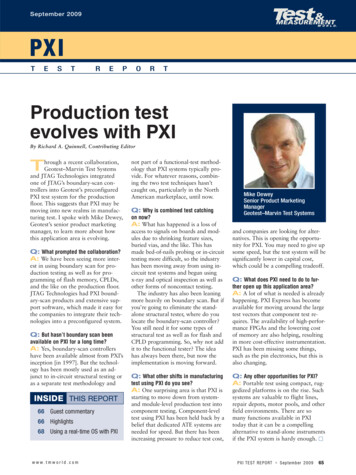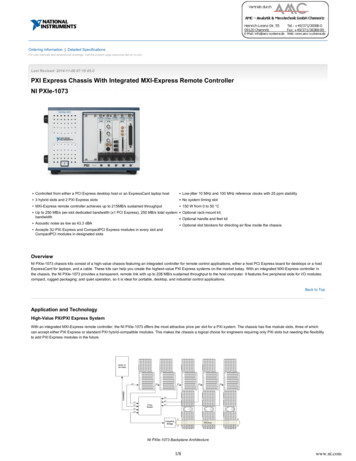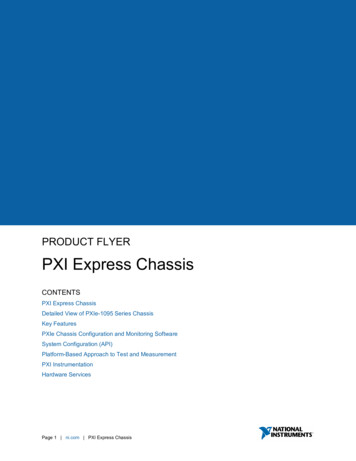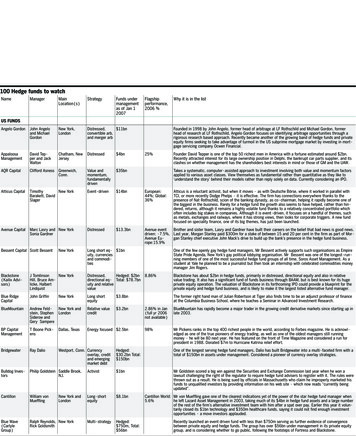
Transcription
September 2009PXITESTREPORTProduction testevolves with PXIBy Richard A. Quinnell, Contributing EditorThrough a recent collaboration,Geotest–Marvin Test Systemsand JTAG Technologies integratedone of JTAG’s boundary-scan controllers into Geotest’s preconfiguredPXI test system for the productionfloor. This suggests that PXI may bemoving into new realms in manufacturing test. I spoke with Mike Dewey,Geotest’s senior product marketingmanager, to learn more about howthis application area is evolving.Q: What prompted the collaboration?A: We have been seeing more interest in using boundary scan for production testing as well as for programming of flash memory, CPLDs,and the like on the production floor.JTAG Technologies had PXI boundary-scan products and extensive support software, which made it easy forthe companies to integrate their technologies into a preconfigured system.Q: But hasn’t boundary scan beenavailable on PXI for a long time?A: Yes, boundary-scan controllershave been available almost from PXI’sinception [in 1997]. But the technology has been mostly used as an adjunct to in-circuit structural testing oras a separate test methodology andINSIDE THIS REPORT66 Guest commentary66 Highlights68 Using a real-time OS with PXIwww.tmworld.comnot part of a functional-test methodology that PXI systems typically provide. For whatever reasons, combining the two test techniques hasn’tcaught on, particularly in the NorthAmerican marketplace, until now.Q: Why is combined test catchingon now?A: What has happened is a loss ofaccess to signals on boards and modules due to shrinking feature sizes,buried vias, and the like. This hasmade bed-of-nails probing or in-circuittesting more difficult, so the industryhas been moving away from using incircuit test systems and begun usingx-ray and optical inspection as well asother forms of noncontact testing.The industry has also been leaningmore heavily on boundary scan. But ifyou’re going to eliminate the standalone structural tester, where do youlocate the boundary-scan controller?You still need it for some types ofstructural test as well as for flash andCPLD programming. So, why not addit to the functional tester? The ideahas always been there, but now theimplementation is moving forward.Q: What other shifts in manufacturingtest using PXI do you see?A: One surprising area is that PXI isstarting to move down from systemand module-level production test intocomponent testing. Component-leveltest using PXI has been held back by abelief that dedicated ATE systems areneeded for speed. But there has beenincreasing pressure to reduce test cost,Mike DeweySenior Product MarketingManagerGeotest–Marvin Test Systemsand companies are looking for alternatives. This is opening the opportunity for PXI. You may need to give upsome speed, but the test system will besignificantly lower in capital cost,which could be a compelling tradeoff.Q: What does PXI need to do to further open up this application area?A: A lot of what is needed is alreadyhappening. PXI Express has becomeavailable for moving around the largetest vectors that component test requires. The availability of high-performance FPGAs and the lowering costof memory are also helping, resultingin more cost-effective instrumentation.PXI has been missing some things,such as the pin electronics, but this isalso changing.Q: Any other opportunities for PXI?A: Portable test using compact, ruggedized platforms is on the rise. Suchsystems are valuable to flight lines,repair depots, motor pools, and otherfield environments. There are somany functions available in PXItoday that it can be a compellingalternative to stand-alone instrumentsif the PXI system is hardy enough. 䡺PXI TEST R EPORT Septem ber 200965
Hardware In The Loop - Fault Insertion40-190Fault Insertion Switch2 Amp 64 Channel40-595Fault Insertion Matrix10 Amp 30 x 840-592Fault Insertion Matrix1 Amp 248 x 840-195Fault InsertionSwitch1 Amp 22 Channel40-1916 Channel, 30A, 40V,Fault Switch40-1947 Channel 20AFault Switch40-19610 Channel 5 AFault Switch40-1926 Channel, 10A,200V, Fault SwitchDetailed Pricing &Technical Data On-LineCome and see our new built in testcapability at Autotestcon, Booth 404Whose Fault is it?That’s why test engineers have turned to Pickering Interfaces for years to solve their “Hardware In The Loop”fault simulation requirements to test and verify safety critical controllers. We provide a range of 12 different –with more to come – PXI-based fault insertion/simulation switching modules, including; First to market with a comprehensive choice of 2A, 5A, 10A, 20A and 30A scalable FI solutions Up to 64 channels of fault insertion in a single slot module BRIC FIBO matrices supporting up to 248 x 8 crosspoints for maximum fault insertion capability Extensive software support including Real Time: LabVIEW RT, QNX, Linux RealTimeWherever safety critical simulation and testing of control modules is required, turn to Pickering for your nextfault insertion test program.See these products at ckering Interfaces Inc., Grants Pass, OR. Tel: 1 541 471 0700E-mail: ussales@pickeringtest.com(East Coast Regional Office) Woburn, MA. Tel: 1 781 897 1710Direct Sales Offices in USA, UK, Sweden, Germany,Czech Republic, France and ChinaSwitch On to Pickeringpickering
PXIT E S TR E P O R TGUEST COMMENTARYCustomizing PXI test systems with FPGAsBy Sebastien Maury, Sundance Multiprocessor TechnologyFor the past decade, PXI-based systems have beensuccessfully deployed for embedded signal-processing applications in data acquisition, industrial control,avionics, automated vision, medical instrumentation, andautomated test. The high performance, modularity, andscalability of the PXI architecture have made it a compelling option for designers who require arugged industrial form factor and real-timecapabilities.Today, designers and system engineersare increasingly deploying FPGA-basedarchitectures to help deliver systems thatare flexible and reconfigurable, support parallel processing, and offer a high data bandwidth. The integration of FPGAs into embedded signal-processing applications offers many benefits and advantages, but managing the diversity of I/O signals associated withFPGAs can make it difficult to interface devices to theexternal world.Whether the I/O interfaces are digital, analog, singleended, or differential, the preferred engineering solutionis to allow designers to customize their FPGA-basedhardware with the required I/O interfaces. Doing thiswhile minimizing cost and customization is key.H I G H L I G H T SChroma unveils pinelectronics moduleThe 36010 pin-electronics modulefrom Chroma ATE is a 100-MHzprogrammable module designed forcharacterizing and testing digital andmixed-signal ICs and electronics. The36010 also supports scan patternfunctions for scan test. Each moduleconsists of a sequence pattern generator and a logic pin-electronics cardwith eight channels.The sequence pattern generator,which provides more than 17 sequence commands to control theflow of pattern execution, isequipped with a 32-Mbyte sequencecommand memory. Each sequencepattern generator can support up toeight logic pin-electronics cards, al-66 S e p t e m b e r 2 0 0 9 PXI TEST REPORTNew-generation FPGA products offer “plug-in” I/Ohardware modules that are flexible enough to offer awide range of interchangeable I/O functionality. Thesemodules can directly interface to an FPGA, or other device, with reconfigurable I/O capability. They are configurable using programmable logic. Using FPGA mezzanineI/O modules can simplify system design, engineeringtime, and integration effort. Additionally, these modulescan streamline the maintenance of the end product andincrease the reusability of the main embedded signalprocessing hardware units.By combining FPGA cards and FPGA mezzanine I/Omodules, users can design and deploy custom instrumentation. And with multichannel ADCs/DACs, RF front-ends,LVDS, LVTTL, Gigabit Ethernet, and serial interfaces, it ispossible for test engineers to architect application-specifichigh-speed digital oscilloscopes, analyzers, arbitrarywaveform generators, RF instrumentation, and vision systems. The combination of PXI and FPGA technology offers test engineers new options for building a modular,scalable system that meets their specific test needs. 䡺Sebastien Maury is the Americas regional director at Sundance Multiprocessor Technology. sebastien.m@sundance.com.lowing it to support up to 64 I/Ochannels and perform testing oneight devices simultaneously.The per-pin timing generator ineach logic pin-electronics card provides 32 sets of clock containing sixprogrammable edges. In the analogfunction, the logic pin-electronicscard has a tri-level driver and comparator with a 610-μV programmableresolution. It also offers active-loadand high-voltage driver functions.www.chromaus.com.NI debuts controllersand a chassisDuring NIWeek 2009 (August 4–6,Austin, TX), National Instruments introduced low-cost PXI Express chassis and controller options for automated test-and-measurement applications. Included in the new offeringsare the 1499 NI PXIe-1073 chassisand the NI PXIe-8102/01 embeddedcontrollers, which start at 2999each.The NI PXIe-1073 chassis, whichfeatures an integrated remote controller, features five PXI Express hybridslots that accept both PXI and PXIExpress modules and an integratedMXI Express controller with a PCIExpress host controller card andcable. Built-in timing and synchronization connections are integrated intothe backplane of the chassis.The NI PXIe-8102/01 embeddedcontrollers can address the needs oftest engineers who require a PXI Express system that couples the PC andchassis in a self-contained system.The NI PXIe-8102 features a dualcore 1.9-GHz Intel Celeron T3100processor, and the NI PXIe-8101 includes a single-core 2.0-GHz IntelCeleron 575 processor. www.ni.com.www.tmworld.com
Envision the possibilitieswww.geotestinc.comGBATS: Geotest’s BasicAutomated Test SystemŶ Outstanding value and flexibility for functionaltest applicationsŶ Standard application configurations for: Mixed signal test Digital test Commercial and military avionics testŶ The fully customizable PXI tester, for lessgreen than you might imaginePlease visit us at AUTOTESTCON, Booth # 811Toll Free: 888.837.8297 Geotest - Marvin Test Systems, Inc. 2009.All rights reserved. Product and trade namesare property of their respective companies.
PXIT E S TR E P O R TUsing a real-time OS with PXIBy Richard A. Quinnell, Contributing Technical EditorGiven PXI’s roots in the PCfield, it is no wonder thatWindows is the dominant operatingsystem for PXI system software. Forsome applications, however, Windowsis not a good match to system requirements, and developers must employ another OS. Development teamsseeking to move beyond Windowsface challenges both in softwareavailability and system programming,but new developments may offer away past such problems. In fact, anevolving virtualization technologymay permit a single test system to runmore than one OS.The drawbacks of WindowsOne of the strengths of PXI is thatthe architecture is able to fully leverage technology advances coming fromthe fast-moving PC field. New processors, advanced interfaces, and development tools that arise in supportof PCs can quickly be incorporatedinto PXI modules and systems. Thesame is true of advances in systemsoftware such as Windows.But Windows is a double-edgedsword when it comes to system control. It enjoys wide support in termsof tools, applications, and developerexpertise, but it also has key drawbacks. Two of the most critical forequipment developers are reliabilityand determinism.Windows can have unpredictabletiming and sometimes will crash forno readily apparent reason, a failingthat is not tolerable in critical applications. “There is nothing mission critical about most manufacturing test systems,” said Wyatt Meek, director ofbusiness development at VI Engineering, “so they can run Windows, and ifit crashes, they can simply reboot. Butwhere operation is mission critical orthere is critical control timing, you’llwant something else.”As an example, Meek pointed tothe JRETS (Jet and Rocket Engine68 S e p t e m b e r 2 0 0 9 PXI TEST REPORTTest System) that VI Engineering developed for WyleLaboratories using multiplePXI systems to handle dataacquisition and control. Thesystem was designed to facilitate hot-fire testing of engineswith as much as 50,000 lb ofthrust, making consistent operation and well-controlledtiming essential.VI Engineering used thePhar Lap ETS RTOS (realtime operating system) insteadof Windows, and used National Instruments’ LabView with the LabView Real-Time module as the programming environment. Reliabilitywas a key reason for this choice.“You won’t have a system crashwith an RTOS if you implement it correctly,” said Meek. “The fear withWindows is getting the ‘blue screen ofdeath’ in the middle of a test.” Meekalso pointed to the maturity of LabView Real-Time, now at version 7, as afactor ensuring stable system operation.In addition to reliability, the JRETSneeded deterministic timing in itscontrol paths. The variation in timing, or OS jitter, that Windows exhibits is typically 500 ms, and even whenWindows is optimized for timing, thejitter can be more than 10 ms, according to Meek. An RTOS achievesjitter in the 1-to-10-ms range, makingthe system quicker to respond to errors, resulting in increased safety.Developers want reliabilityEven for systems that do not havesuch mission-critical requirements,however, some developers are lookingfor an alternative to Windows, according to Matthew Friedman, senior PXIplatform manager at National Instruments. “A lot of users simply wantmore confidence in the reliability oftheir systems,” said Friedman. “Theymay also be looking for a higher degree of synchronization between theFor some developers of PXI systems,the reliability and functional stabilityof operating systems such as Linuxoffer an appealing alternative toWindows. Courtesy of Sekas.controls driving the test and the measurement.” Other reasons for choosingan alternative OS include vendor independence, version stability, and freedom from licensing fees.If a PXI test system uses an external computer as the system controller,that computer can be running Windows, MacOS, Linux, or nearly anyother OS that can send the appropriate commands. If the controller is embedded, however, off-the-shelf alternatives narrow.Only a handful of manufacturersof PXI controllers support alternatives to Windows. Keithley Instruments, for instance, offers Linux forits controllers. NI has controllerswith an embedded RTOS. MENMikro Electronik supports Linux,QNX, or VxWorks, depending on thecontroller model. Adlink has a LinuxAPI (application programming interface) and driver library for its controllers and data-acquisition cards,and Team Solutions offers Linux drivers for the GPIB and PXI triggerfunctions built into its modular-CPUcontroller. Because the controller utilizes industry-standard plug-in CPUmodules, however, OS support mustcome from the CPU module vendor.www.tmworld.com
If the controller is running an alternative OS, other system modules willrequire drivers appropriate to thatOS. This can present developers witha challenge. “Not a lot of vendorshave nonWindows drivers,” saidMeek, “so there is a smaller range ofresources available for developers.”Even when drivers are available,Meek noted, they may not supportsome of the module functions that theWindows drivers do.Embracing a Windows alternativecan also limit your options for application software. “Developers shouldlook at which programs support theirOS,” said Meek, and he explainedthat if the test-control software doesnot run under the desired RTOS, developers will need to create their owntest-sequencing engines.There has been some industry activity to fill the gaps, at least for specific system configurations. LabViewReal-Time, for instance, supportsVISA (virtual instrumentation software architecture) drivers. So, if amodule’s driver is VISA-compliant, itwill work under LabView Real-Time.The German company Sekas is offering software that makes the Rohde& Schwarz CompactTSVP (test systemversatile platform), which is used inautomotive and telecommunicationstest, compatible with Linux. The Sekassoftware—TSVP-LXLib—replicatesthe software infrastructure that IVI(Interchangeable Virtual Instrument)drivers need, making it easier for developers to port the drivers to Linux.twice about simply making thechange on their own. “Bringing upa controller board under a new OScan be painful,” said Garcia. “So,having out-of-the-box support foran RTOS from the board vendor isimportant.”VI Engineering’s Meek also pointedout that moving a traditional PXI testapplication to a real-time system mayrequire a learning curve. “You can’tjust take normal LabView code andhave it work in real-time,” saidMeek. “You need to architect yourEvaluate system needsFor the most part, however, PXI developers seeking an alternative to Windows must evaluate their choice carefully. “Survey your current needs to ensure that you have support for the newOS,” said Gerardo Garcia, group manager for real-time software at NI.“Also, check to see if you are using OSspecific features such as ActiveX, whichis only available under Windows. Youneed to make a full audit of what youare actually doing in your system.”Developers who are seeking touse an RTOS should also thinkwww.tmworld.comPXI TEST R EPORT Septem ber 200969
PXIT E S TR E P O R T 225 Wyman St., Waltham, MA 02451Phone: 781-734-8423 Fax: 781-734-8070Sales e-mail: tmwsales@reedbusiness.comWeb: www.tmworld.comprogram to allow independentthreads, set priorities, and the like.This might not be difficult for a specific test, but it gets tricky if you aretrying to design a generic system withlooping and such. This adds cost andcomplexity to the development effort.You have to ask if the advantages ofan RTOS are worth it.”BUSI N E S S S TA F FPublisher: Russell E. Pratt,rpratt@reedbusiness.comAssociate Publisher: Judy Hayes,judy.hayes@reedbusiness.comDirector, Custom Programs and Solutions:Karen Norris-Roberts, knorris@reedbusiness.comOnline Account and Marketing Manager:Melanie Turpin, melanie.turpin@reedbusiness.comVirtualization is on the horizonAssistant to the Publisher: Darlene FisherOnline Client Services Manager: Jennifer CarusoMarket Research Director: Rhonda McGeeGroup Production Director: Dorothy BuchholzProduction Manager: Joshua Levin-EpsteinCustomer Contracts Coordinator: Donyetta JenkinsADVE RT I S I N G S A L E SCT, NJ, New York City, Long Island:Mike Moore, Chatham, NJ. 973-701-93401.mikemoore@gmail.comMidwest, Southeast, NY (except NYC & LI), PA,MD, DE, and Canada:James Leahey, Kenosha, WI. 262-656-1064james.leahey@reedbusiness.comCA, CO, TX, and Northwest:Mary Lu Buse, Calabassas, CA. 818-880-4024marylu.buse@reedbusiness.comNew England, South Central; Classified, Test Marts,TestLits, and Account Development Nationwide:Kathy McNamara, Waltham, MA. t Sales Director:Laura Lang-Dacus, e, Spain, UK, Ireland, Benelux, Scandinavia:John Waddell, London, England. 44-20-8312-4696Germany, Austria, Switzerland: Adela Ploner, Dachau,Germany. 49-8131-366992-0Italy: Roberto Laureri, Milan, Italy. 39-02-236-2500Israel: Asa Talbar, Tel Aviv, Israel. Fax: 972-3-562-9565Japan: Shintaro Koyama, Tokyo, Japan.81-3-3402-0028Korea: Belle Jung, Seoul, Korea. 822-511-0660Taiwan: Laura Chen, Taiwan, ROC. 886-2-2314-7206Singapore, Malaysia, Hong Kong: Wai Chun Chen,Singapore. 65-6544-1151VOL. 29, NO. 8Subscription PolicyTest & Measurement World (ISSN 0744-1657) (GST Reg.#123397457) is published monthly except January by Reed Business Information, 8878 S. Barrons Blvd., Highlands Ranch, CO80129-2345. Reed Business Information, a divisio
The NI PXIe-1073 chassis, which features an integrated remote control-ler, features five PXI Express hybrid slots that accept both PXI and PXI Express modules and an integrated MXI Express controller with a PCI Express host controller card and cable. Built-in timing and synchroni-zation











